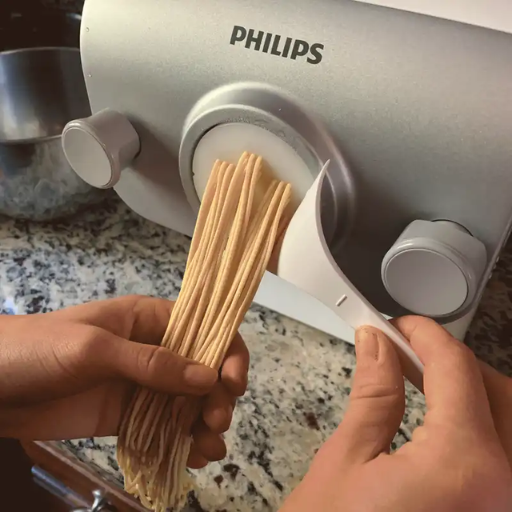There’s nothing like enjoying fresh homemade pasta if you’re into pasta. In 2024, we have more pasta makers to choose from than ever before. Innovations and features are available for beginner cooks and professional chefs alike. Our all-inclusive guide is here to help you find your way through the many options to find the best pasta maker for your needs and aspirations in cooking. We look at products ranging from manual machines that will transport you back to traditional Italian kitchens to advanced electric models that take the guesswork out of making perfect noodles every time. We will cover things like ease of use, durability, price point, and extra features – pointing out what’s essential while leaving no stone unturned! Our guide equips readers with everything they need to know about picking their next home appliance wisely, whether it be classic spaghetti lovers or those craving ravioli filled just right with this year’s top picks; our guide covers it all.
What is an Electric Pasta Maker, and How Does it Work?
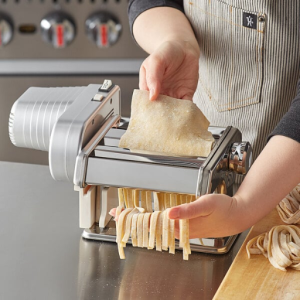
Image source: https://www.webstaurantstore.com/
An electric pasta maker is a device that can be used to make pasta. It is better than any traditional hand-operated machine because it requires little effort or time. These machines are usually made up of one motorized unit with different attachments and settings, which are meant to mix, knead, and extrude various doughs into different shapes of noodles. Once the ingredients such as flour, water, and eggs have been put into this appliance, mixing and kneading them will be done by the machine itself, thus ensuring uniformity in the texture of the dough always produced by it. Then, what follows is pushing the prepared mixture through customized dies or cutters to come up with the specific forms of pasta that someone wants. Also, adjustable controls enable one to effortlessly make all sorts of pasta using this equipment, ranging from thin spaghettis up to wide lasagnas.
Understanding the Basics of an Electric Pasta Machine
To know how an electric pasta machine works, it is crucial to understand its main parts and their respective functions. First is the motorized foundation, which powers the whole thing; then comes the mixing chamber, where all ingredients are brought together, followed by a pasta extruder with interchangeable shaping discs. You begin by putting flour, water, and eggs into this container. After that, the device mixes everything until you get a dough with the right consistency required for making various types of spaghetti, among other shapes, such as fettuccine or penne. Often, these machines come with adjustable settings to choose the thickness of their dough and the length desired for the final product, thus allowing customization while ensuring that it always turns out great. Electric kneading and shaping devices like this save energy by doing most of the work on behalf of human beings.
What is a Pasta and Noodle Maker?
A pasta and noodle maker is a kitchen gadget made to help with making fresh pasta and noodles at home easily. It does this by doing specific steps automatically, such as mixing, kneading, and extruding dough, creating different shapes of pasta or noodles without much effort. The usual procedure involves adding ingredients like flour, water, eggs, etc., into the mixing chamber of the machine, selecting the desired type of pasta/noodle through interchangeable dies, and adjusting thickness/length settings accordingly. After these are done, all that remains is for one to wait as the device works on its own, producing consistent, high-quality outputs within short durations. Pasta and noodle makers are perfect for people who want homemade pasta but don’t have enough time or energy to make them manually.
Benefits of Using an Electric Pasta Extruder
Electric pasta extruders have many attractive benefits as they make the process of making pasta easier and quicker. For one thing, they automate mixing, kneading, and extruding, which saves time as you can produce fresh pasta fast. These machines can often achieve better results than manual methods because the texture is consistent while shapes are uniform throughout different batches. Not only this, but it also ensures top quality every single time. Moreover, their versatility cannot be ignored since there are interchangeable dies and adjustable thickness settings for length, thus allowing spaghetti fettuccine or penne to be made using just one device. Ultimately, what makes electric pasta extruders fun to use is that anybody can operate them; hence, even beginners in cooking will find these gadgets easy to work with; besides, this feature gives an enjoyable and satisfying experience during preparation, so much so that homemade becomes more of a practical than rewarding culinary activity.
Which Pasta Machine is Right for You?
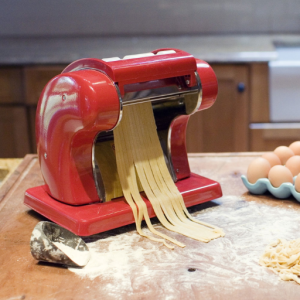
Selecting a suitable pasta machine can depend on many things, like price range and how often one plans on making pasta, among other factors. A manual pasta maker could be good for those who like to be more hands-on or appreciate doing it the old-fashioned way. They tend to cost less and allow greater control over dough texture and thinness. On the other hand, if convenience is critical, then an electric extruder might be more suitable due to its automation and variety of use, which makes it perfect for people who make pasta frequently or simply want quick, easy noodles every time. Also, look out for features such as adjustable thickness settings, interchangeable dies, etc., to get a machine designed specifically for your pasta-making needs.
Comparison: Electric Pasta Maker vs Manual Pasta Maker
When comparing electric and manual pasta makers, consider which one is easier to use, more flexible, faster, and allows for better control over the pasta-making process.
- Ease of Use: Electric pasta machines are highly automated and require a little effort from the user; this feature makes them perfect for beginners or those without much time.
- Speed: They can be faster generally as they can automate parts that take more time, thus producing a lot of pasta within a short period.
- Versatility: Electric Pasta Makers usually come with several dies and settings, which enable people to create different shapes of pasta without any difficulties regarding thickness adjustment.
- Convenience: The involvement of machines in most steps means less direct engagement from individuals using them, henceforth making them convenient.
Manual Pasta Maker:
- Control: Manual Pasta Machines allow users to regulate the texture and size of dough more precisely, enabling them to have hands-on involvement with an old-fashioned touch.
- Affordability: Generally speaking, manually operated ones are cheaper than their electrical counterparts, thus making them affordable for people working with tight budgets.
- Maintenance: These devices are usually easy to clean since they do not contain many intricate parts that might require special attention during cleaning sessions.
- Experience: For some individuals, using hands may bring about personal fulfillment or satisfaction during cooking processes with such appliances; therefore, the tactile nature associated with this type appeals to many users due to its simplicity factor alone.
In conclusion, if convenience, speed, and versatility are important factors, then you should opt for an electric machine. But if what matters most is control over the entire process coupled with affordability tinged with traditionalism while cooking, then a manual one will do just fine.
Exploring the Features of the Philips 7000 Series Pasta
For its futuristic and easy-to-use features in homemade pasta making, the Philips 7000 Series Pasta Maker is unbeatable. One of the main features includes a powerful 200W motor that mixes and extrudes dough within ten minutes, thus saving the time needed for preparation. This appliance has many shaping discs that allow you to make eight different types of pasta, including penne, fettuccine, and spaghetti, among others. In addition, an integrated scale automatically weighs flour and shows the correct amount of liquid required, hence ensuring uniformity in results.
Furthermore, there are pre-set programs on this device with a user-friendly interface, making it very simple even for beginners to operate. The parts can be removed for cleaning since they are dishwasher safe, thus promoting easy maintenance. This machine is made of solid and high-quality plastics and stainless steel materials; therefore, it can withstand continuous usage without compromising efficiency. Speed, convenience, and versatility are what you get from Philips 7000 Series Pasta Maker. Whether your culinary skills are advanced or basic home-cooking knowledge – it will still serve its purpose well in any kitchen setting.
How to Choose the Best Pasta Machine for Your Needs
When choosing a pasta machine for your kitchen, there are a few things you should keep in mind if you want it to satisfy all of your needs and desires. The first thing that should be done is deciding between an electric or manual model. Manual machines such as the Marcato Atlas 150 offer hands-on experience and are also cheaper and more durable in most cases. However; electric models like Philips 7000 Series Pasta Maker make extruding dough conveniently by doing it automatically besides featuring several different pasta shapes.
Moreover, one should consider how easily the appliance would be used and cleaned afterward. Interfaces that users can easily understand, preset programs, and parts that can be detached and then cleaned using dishwashers could save much time while making pasta. Equally important is that the equipment is made of good-quality stainless steel or any other material that does not break easily so that it lasts long enough without failing to function consistently.
Furthermore, another factor to look at when buying these machines is their flexibility; those with many shaping discs plus adjustable thickness settings allow one to try out various types and styles of pasta. Last, check on capacity alongside motor power so that more significant amounts of pasta can be made within short periods without overworking the machine.
Considering these points will enable you to choose a pasta-making device that will help bring out your culinary dreams while still thinking about what suits best for the kitchen, thus turning homemade pasta into an enjoyable activity free from troubles.
Can You Make Fresh Pasta at Home with a Pasta Roller?

Indeed, using a pasta roller is one way to prepare fresh pasta at home. Making quality pasta requires dough sheets rolled out to the correct thickness and the exact size all through; this can be done quickly using a pasta roller, which simplifies this process. You can get uniform pieces such as fettuccine, lasagna, or tagliatelle by cutting even sheets produced when you feed your dough into rollers. Not only does it save time but also ensures that there is evenness in rolling unlike when done manually where some parts may take longer than others hence become thin or thick spots. With enough trials, anyone can find making fresh pasta with a roller easy and fulfilling task.
Using a Pasta Roller and Cutter Set
The employment of a pasta roller and a cutter set can significantly simplify preparing fresh pasta at home. Begin this by making your pasta dough using any recipe you like most. Once you finish the dough, divide it into small portions and lightly press each piece using your hands. At this point, take your pasta roller and put it on its widest setting, then feed the dough through these rollers while folding and re-rolling several times until smoothness is achieved. Lower the thickness dial gradually to achieve the desired thinness level by passing each time.
When cutting the noodles, attach a cutter that matches what you want, such as spaghetti or fettuccine. Put flattened sheets of dough into the cutter so as to get even-shaped stripes. Sprinkle some flour on fresh cuts to prevent them from sticking together before they dry a bit before cooking them. This system gives reliable outcomes throughout, thus changing plain components into appetizing homemade pastas.
Tips for Perfect Pasta Dough with an Electric Pasta Maker
- Use Quality Ingredients: Use good ingredients. For example, choose fine flour, mostly known as “00” or semolina flour and fresh eggs. This will make the dough smoother and more elastic.
- Correct Consistency: The dough should not be too wet or too dry. It should be firm when you touch it but not sticky. If need be, add small amounts of water or flour to achieve the desired consistency.
- Knead Properly: Kneading the dough helps distribute the ingredients evenly and makes it supple and elastic. You can knead by hand for about 10 minutes or use a stand mixer for approximately 5 minutes.
- Rest the Dough: Wrap the dough in plastic wrap and allow it to rest for at least half an hour. This relaxes the gluten, making it easy to roll out later.
- Proper Thickness Setting: Start rolling out your pasta with an electric pasta maker set on its widest setting. Work your way down gradually until you get to the desired thinness level. Pass every setting several times so that the pasta is of even thickness throughout.
- Avoid Overloading: Too much dough in the machine can strain it, resulting in unevenly cut pasta shapes. Always work with small portions at a time for the best outcomes.
- Use Correct Attachments: Ensure that you have chosen appropriate attachments for making different shapes of pasta and follow the instructions provided by the manufacturer on how best to use them.
- Flour Dusting: Sprinkle flour on both sides of the dough sheets before feeding them through rollers to prevent sticking. However, do not use excess flour, as this may affect the texture of the final product.
If followed closely, these hints will enable anyone using an electric pasta maker to create perfect pasta dough every time.
Homemade Pasta Tips and Tricks
Creating pasta from scratch is rewarding; however, knowing how to dry and store homemade pasta properly is critical for it to maintain its freshness. Below are some essential tips on how to keep the dough perfect until you want to use it:
- Drying: If you plan on storing the pasta you made for future use, let it dry completely, either on a drying rack or a clean, floured surface. Make sure that each strand or piece is spread out evenly so they don’t stick together. The duration of drying may differ due to humidity, but it usually takes between 12 and 24 hours; for shorter pasta shapes, flip them occasionally during this period of time so all sides get dried equally.
- Storing Fresh Pasta: Freshly made pasta can be stored in the refrigerator for up to two days by putting it into an airtight container or resealable plastic bag. Another option would be freezing fresh pasta: lay it down flat on baking sheets, then freeze until solid before transferring it into freezer-safe bags.
- Storing Dried Pasta: Once your homemade noodles have thoroughly dried out, place them inside an airtight container at room temperature, where they will keep well for several months. Always remember never to expose any dried pasta to cool places away from sunlight, as this might cause it to turn stale quickly or absorb moisture.
If these guidelines are followed, there won’t be any compromise with quality when cooking with homemade pasta because it will be ready whenever one needs it.
How Do You Use a Pasta Press Attachment?
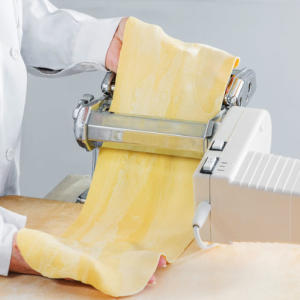
Using an attachment for a pasta press is a simple thing that can make making pasta easier and more fun. Here’s what you do:
- Make the dough: Follow your recipe to prepare your pasta dough. Make sure it’s well kneaded and smooth for best results with the press.
- Attach to stand mixer: Connect the pasta press attachment to your stand mixer, ensuring it is securely attached before starting.
- Cut the dough: Divide the dough into smaller pieces—manageable sections. Lightly flatten each piece with your hands or rolling pin.
- Feed dough through the press: Turn on the low-speed setting on the mixer, then feed one of these flattened portions until the desired thickness is achieved via pressing. If necessary, cut the extruded pasta into desired lengths using the cutter attachment provided.
- Catch Pasta as It Comes Out: As soon as extruded, lay them down gently onto any floured surface or drying rack to avoid sticking together.
- Do Again: Repeat process above using rest of dough until enough pasta made.
This way, you will get fresh homemade pasta ready for cooking or storing in no time. Just follow these steps.
Step-by-Step Guide to Using the Gourmet Pasta Press Attachment
Using this gourmet pasta press attachment can do wonders for your homemade pasta. It can help shape your dough into perfect shapes and textures. Here’s a quick guide:
- Prepare The Dough: Stick to your favorite pasta dough recipe and ensure it is well-kneaded and rested. You need This foundation if you want a smooth elastic dough that can easily pass through the press.
- Attach the Pasta Press: Firmly fix the gourmet pasta press on your stand mixer. Follow the manufacturer’s instructions on how to connect all parts properly to avoid problems during operation.
- Cut and Flatten the Dough: Cut your prepared dough into small portions, then slightly flatten each piece using your hands or a rolling pin so that it is easy to feed into the press.
- Feed the Dough: For beginners, set the stand mixer at low speeds, usually denoted by numbers. Feed the flattened dough through the press.
- Shape the Pasta: Use different attachments and settings in a pasta press to shape your pasta. Adjust thickness while cutting lengths according to the desired shape of spaghetti, fusilli, or rigatoni.
- Collect and Dry: As soon as it comes out, gently catch it, then put it on a floured surface or drying rack one after another without sticking together, thus maintaining its design.
- Repeat Process: Keep going until there is no more dough left by feeding, shaping, and collecting it all rapidly before drying out too much, which might cause difficulties during cooking later.
If you follow these steps correctly, fresh gourmet quality ready-to-eat or dry cookable spaghetti will be produced every time.
Best Practices for Attachments with KitchenAid Pasta Maker
- Read the Manual: Thoroughly read the instruction manual provided by KitchenAid before using any attachments. This will help you understand different attachments and how to care for them for longer life.
- Properly Secure Attachments: Ensure each attachment is correctly connected to your KitchenAid mixer. Wrong attachment placement may cause uneven pasta or damage to the machine. Check twice before turning on the mixer to see if they are joined well.
- Use the Correct Speed Settings: Different pasta shapes may require different blender speed settings. Slower speeds generally work better for simple and uniform pasta production. Follow the instructions in your attachment.
- Keep Dough Consistency in Mind: Your dough should not be too dry nor too sticky. It should hold together but not be gummy to pass through the pasta press easily.
- Clean Attachments Properly: Clean attachments well after every use as per manufacturer’s instructions; some parts should not come into contact with water, use a dry cloth or brush supplied instead.
- Regular Maintenance: Check your attachments regularly for signs of wear and tear, replace broken pieces, and lubricate moving parts where necessary to ensure smooth running.
- Experiment with Different Settings: Thickness and shape settings can be varied at will; this helps one find out what they like most and which works best for various types of pasta.\
Follow these guidelines for top efficiency while using Kitchen Aid pasta making machine connection gadgets; such practices guarantee uniform output always.
What are the Best Electric Pasta Makers in 2024?
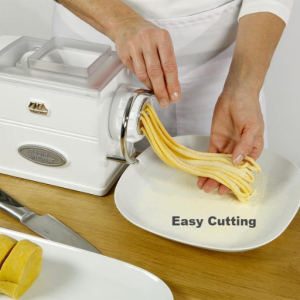
For 2024, the best electric pasta makers are efficient, easy to work with, and give good results. The Philips Pasta Maker Plus is an automatic machine that tops this list by allowing users to make all kinds of pasta without struggling. Another great option is the KitchenAid 3-Piece Pasta Roller and Cutter Set, which is versatile and durable and can be attached to any KitchenAid mixer. It is compact but highly functional, so if you want something small but still capable, go for Marcato Atlas Pasta Machine Electric Motor Attachment, known for its strength and consistency when producing pasta at home in 2024. Each one of them represents what people consider to be creative, convenient inventions for making noodles at home in 2024.
Review of the Atlas 150 Pasta Machine
The Atlas 150 Pasta Machine is considered by many to be one of the best manual pasta makers available because it combines excellent workmanship with ease of use. Users and experts value its durability and long life, achieved through chrome-plated steel in its robustly built body. It has a nine-setting thickness dial that enables you to control the thinness of your pasta dough accurately – an essential factor when making everything from fettuccine noodles to lasagna sheets.
What sets the Atlas 150 apart is its ability to produce smooth, consistent, even strands thanks to polished rollers. The machine also includes a dual-side cutter for tagliolini or fettuccine. For those who want convenience over hands-on time savings, you can buy an attachment that turns this model into an electrically powered device.
This maker can be easily cleaned as all parts are removable for wiping clean. However, do not wash with water; instead, brush off any stuck dough bits using a wooden stick or similar implement.
In general, reviewers rave about how well this thing works every single time they use it, versatility being another strong suit — most people seem thrilled at what they’re able to produce using just one tool; reliability too – once again, many folks state theirs has lasted years without issue so far… In short, if you love eating fresh homemade pasta but hate having to put up with making your own, then look no further than this machine because not only does it combine traditional methods alongside today’s efficiency levels, thereby ensuring authenticity throughout each batch made which should keep both beginners happy as clam chowder while still allowing seasoned chefs enough room left over within which challenge themselves further thus guaranteeing satisfaction all round.
Exploring the Imperia Pasta Maker
The Imperia Pasta Maker is another popular manual pasta machine due to its solid and typical Italian design. This unit’s robustness, made of chrome-plated steel, is aimed at extending its life span. Like the Atlas 150, it has thickness settings that can be adjusted according to one’s preference; these settings allow a person to choose from six different levels of pasta dough thickness for various dishes. This option allows for many styles, such as angel hair or lasagna sheets, to be made accurately.
A wooden-handled crank is among the features that stand out in the Imperia Pasta Maker; this feature adds authenticity to pasta making. This aspect was designed with simplicity in mind, so even beginners will find it easy to use. In addition, dual cutting heads are provided with every purchase, which makes thin spaghetti as well as wider fettuccine, hence broadening its range.
Keeping clean should not pose any problem. One only needs a brush or cloth to wipe off the remaining dough since it shouldn’t be underwater. Such simplicity when handling contributes significantly to attracting home cooks who want simple but efficient ways to make their pasta.
The Imperia Pasta Maker has been commended for its consistent quality output, ease of use, and capability to produce various pasta types. Many people compare this machine to Atlas 150; however, each has some unique strengths, while others, like traditional pasta, look better, making Imperia their best choice.
Top Brands: Philips, Hamilton Beach Electric Pasta Maker
Philips Pasta Maker
The Philips noodle maker is fast and easy to use. It can make fresh noodles in just ten minutes. This machine considerably simplifies the process of making pasta because it has a powerful motor that automatically mixes, kneads, and extrudes. With many shaping discs included, you can consistently create various types of pasta, such as spaghetti, penne, or fettuccine. Its design is compact so that storage becomes more accessible than ever before; also, all parts are dishwasher safe, making cleaning more convenient. These features have made it loved by many home chefs.
Hamilton Beach Electric Pasta Maker
The electric pasta machine from Hamilton Beach is known for being very user-friendly and versatile. Different pasta recipes can be tried with multiple settings to customize thicknesses. It takes care of everything required for preparing noodles automatically, from mixing ingredients up to extruding them, thus ensuring seamless operations even among novices. Notably, this particular model offers stepwise instructions that are easy to follow alongside several discs that allow one to create different shapes while at it. Built using solid materials but still lightweight enough not to strain anyone during handling, keeping clean after use does not pose any challenge either, as all these qualities contribute towards making it one dependable kitchen asset.
Philips is often considered faster and more convenient than other brands like Hamilton Beach, whose machines take longer but offer greater control over thicknesses, etcetera; however, some people may find Philips’ limited options boring, especially when dealing with diverse dietary requirements, hence their preference for H.B with additional guides explicitly meant for beginners who need extra support during their initial attempts into homemade noodle creation – nevertheless each brand delivers robust performance catering towards various needs within the home-based pasta industry.
Why Should You Invest in an Electric Pasta and Noodle Maker?
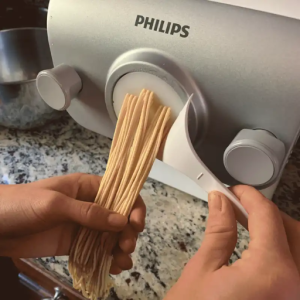
You can make fresh homemade pasta without much struggle by purchasing an electric pasta and noodle maker. These devices simplify the process of making pasta, saving your time and energy while always guaranteeing uniform results. You have healthier options because they allow for ingredient customization and different shapes of noodles, which can be good for you since no preservatives are used in such meals. Also, electric pasta machines foster culinary innovation by giving room for trial and error regarding various recipes or flavors one may want to try out. In terms of convenience alone, these gadgets are efficient enough, but what sets them apart is their ability to produce superior-tasting pastas than any other method currently available on the market; hence, they should never be missed in any kitchen.
The Convenience of Automatic Pasta Making
To make the pasta, automatic pasta-makers need just a few buttons to set it up. According to reputable sources such as Serious Eats, Williams Sonoma, and Epicurious, these machines can mix, knead, and extrude dough in record time. In most cases, you won’t have to spend more than 20 minutes making fresh pasta from home – all it takes is cleaning up easy-to-clean parts that are often dishwasher-safe, too! Consistency should also be mentioned; each device ensures a perfect texture every single time while infusing flavors into them well enough for one not to be able to tell whether they came out of an Italian restaurant or their kitchen. This convenience leads to broader cooking experimentation, eventually leading us towards healthier eating options, thus making this appliance an invaluable part of any modern household’s kitchen setup.
Creating Different Pasta Shapes with a Noodle Machine
You can make many different kinds of pasta to suit all tastes using a pasta machine. Most electric pasta machines have several extrusion discs that allow for the making of spaghetti, fettuccine, penne, and lasagne sheets, among other shapes too, according to top-rated sources such as Pasta Evangelists or The Spruce Eats or Food Network. Some more advanced models may even include attachments that enable users to create ravioli or tortellini – endless possibilities! Different shapes mean that one can prepare anything from classic Italian dishes through more creative gourmet recipes down to quirky fun foods for kids’ parties or even just an everyday dinner at home with friends.
Benefits of Using a Machine with 7 Molds for Spaghetti
According to The Kitchn, Bon Appétit, Good Housekeeping, and many other leading sources of food information, using a machine with seven molds for spaghetti has several advantages. To begin with, the different molds can produce spaghetti strands of varying thicknesses or types, thus catering to different culinary preferences and textures. This range also makes it easier to personalize pasta dishes, improving their taste and appearance. In addition, multiple molds guarantee uniformity in thickness and length of spaghetti strands – this is important for even cooking and good sauce adhesion. Finally, many molds decrease individual wear and tear on parts, enhancing overall durability while maintaining high-performance levels throughout its life cycle since different components get used at other times. Such diverse functionality makes this device indispensable for every lover of pasta.
Frequently Asked Questions (FAQs)
Q: What features should I look for in the best pasta makers of 2024?
A: When choosing the best pasta makers of 2024, consider features such as construction material (stainless steel pasta makers are durable), ease of use, type (manual or electric), included pasta cutter and roller attachments, and any special features like automatic pasta making and pasta drying functions.
Q: How does the KitchenAid pasta roller attachment compare to other pasta makers?
A: The KitchenAid pasta roller attachment is highly regarded for its compatibility with KitchenAid stand mixers, ease of use, and ability to make pasta efficiently. It might not offer the same versatility as standalone machines like the Imperia pasta or Atlas 150 pasta machine, but it is a convenient option for existing KitchenAid users.
Q: What are the benefits of an automatic pasta maker over manual pasta machines?
A: Automatic pasta makers, such as the Philips 7000 Series Pasta machine, simplify the pasta-making process by mixing, kneading, and extruding dough automatically, saving time and effort. At the same time, manual pasta machines are often less expensive, require more hands-on work, and might have a steeper learning curve.
Q: Is the Imperia pasta maker a good choice for making gourmet pasta at home?
A: Yes, the Imperia pasta maker is a popular choice for gourmet pasta enthusiasts due to its robust build, ease of use, and high-quality pasta it produces. It also offers compatibility with various pasta cutter attachments, allowing for different pasta types.
Q: Are there compact pasta makers suitable for small kitchens?
A: Yes, several compact pasta makers are available, such as the Hamilton Beach Electric Pasta Maker and handheld electric pasta makers. These smaller machines are designed to save space while providing the functionality needed to make pasta at home.
Q: How do I properly dry pasta made with a pasta and noodle maker machine?
A: Pasta drying can be done using a pasta drying rack, which allows the pasta to hang and air dry evenly. Ensure the pasta is spread out and not clumped together to prevent sticking. Drying times vary depending on the type of pasta used and the environmental conditions.
Q: What is the advantage of using a machine with seven molds for spaghetti and other pasta types?
A: A machine with seven molds, like some models of the Philips 7000 Series Pasta maker, provides versatility by allowing users to make different pasta shapes and sizes, such as spaghetti, fettuccine, and macaroni, all in one machine. This eliminates the need for multiple devices and broadens your culinary possibilities.












